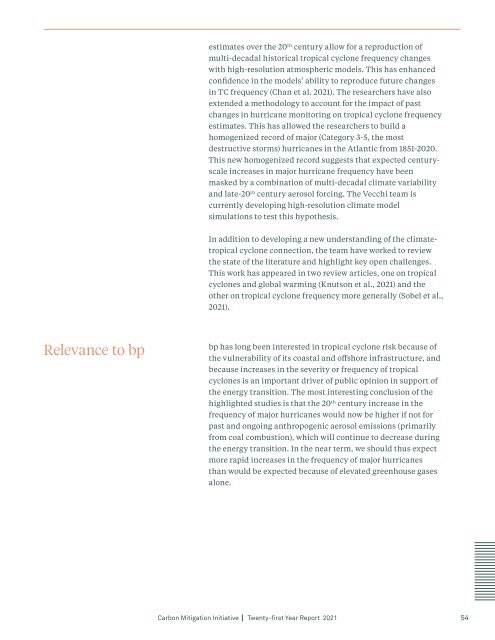CMI Annual Report 2021
Create successful ePaper yourself
Turn your PDF publications into a flip-book with our unique Google optimized e-Paper software.
estimates over the 20 th century allow for a reproduction of<br />
multi-decadal historical tropical cyclone frequency changes<br />
with high-resolution atmospheric models. This has enhanced<br />
confidence in the models’ ability to reproduce future changes<br />
in TC frequency (Chan et al. <strong>2021</strong>). The researchers have also<br />
extended a methodology to account for the impact of past<br />
changes in hurricane monitoring on tropical cyclone frequency<br />
estimates. This has allowed the researchers to build a<br />
homogenized record of major (Category 3-5, the most<br />
destructive storms) hurricanes in the Atlantic from 1851-2020.<br />
This new homogenized record suggests that expected centuryscale<br />
increases in major hurricane frequency have been<br />
masked by a combination of multi-decadal climate variability<br />
and late-20 th century aerosol forcing. The Vecchi team is<br />
currently developing high-resolution climate model<br />
simulations to test this hypothesis.<br />
In addition to developing a new understanding of the climatetropical<br />
cyclone connection, the team have worked to review<br />
the state of the literature and highlight key open challenges.<br />
This work has appeared in two review articles, one on tropical<br />
cyclones and global warming (Knutson et al., <strong>2021</strong>) and the<br />
other on tropical cyclone frequency more generally (Sobel et al.,<br />
<strong>2021</strong>).<br />
Relevance to bp<br />
bp has long been interested in tropical cyclone risk because of<br />
the vulnerability of its coastal and offshore infrastructure, and<br />
because increases in the severity or frequency of tropical<br />
cyclones is an important driver of public opinion in support of<br />
the energy transition. The most interesting conclusion of the<br />
highlighted studies is that the 20 th century increase in the<br />
frequency of major hurricanes would now be higher if not for<br />
past and ongoing anthropogenic aerosol emissions (primarily<br />
from coal combustion), which will continue to decrease during<br />
the energy transition. In the near term, we should thus expect<br />
more rapid increases in the frequency of major hurricanes<br />
than would be expected because of elevated greenhouse gases<br />
alone.<br />
Carbon Mitigation Initiative Twenty-first Year <strong>Report</strong> <strong>2021</strong><br />
54
















